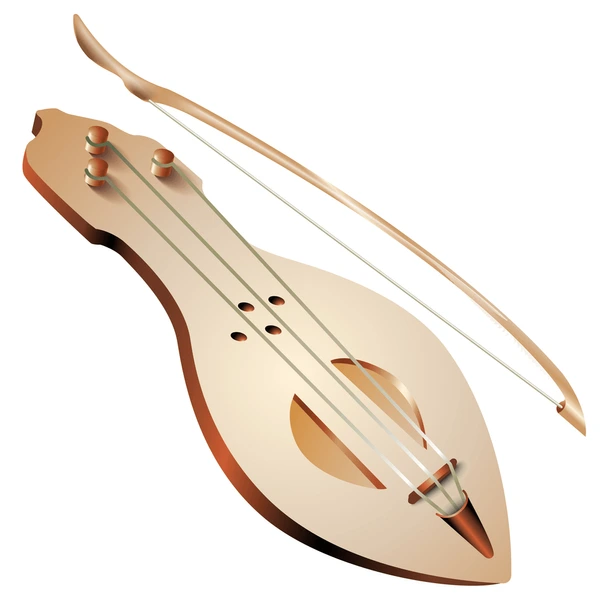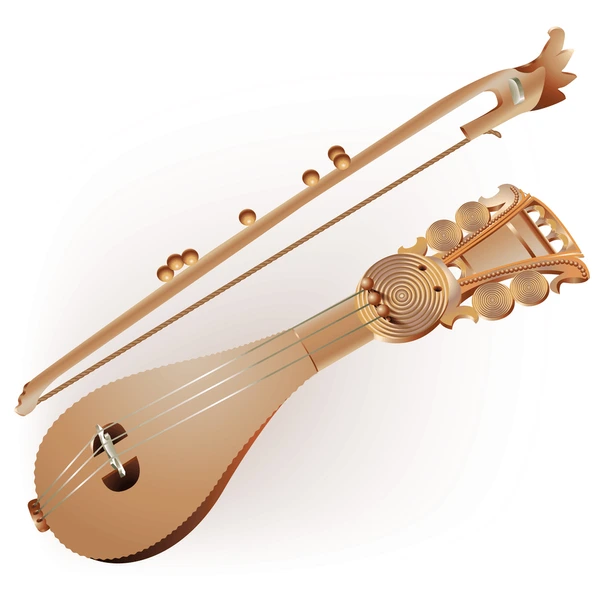Gadulka
Bowed Instruments
Europe
Between 1001 and 1900 AD
Video
The Gadulka is a traditional Bulgarian string instrument with a rich history and distinctive sound. Known for its unique resonance and emotional depth, the Gadulka has long been a vital part of Bulgarian folk music and cultural identity. Whether played in the countryside or during festive occasions, the Gadulka evokes a sense of nostalgia and connection to Bulgaria’s deep musical traditions.
History and Origin of the Gadulka
The Gadulka is believed to have originated in Bulgaria and has been a staple in the country’s folk music for centuries. Its exact origins are difficult to pinpoint, but it is widely thought to have emerged sometime during the medieval period, around the 12th or 13th century. The instrument is believed to be influenced by the ancient Byzantine and Ottoman traditions, with similar instruments found in neighboring countries such as Greece, Turkey, and Serbia. Despite these regional similarities, the Gadulka has evolved into a unique Bulgarian instrument, particularly favored for its ability to convey the emotional depth of the country’s folk music.
Over time, the Gadulka became a central part of Bulgarian folk ensembles, used primarily in celebrations, rituals, and communal gatherings. Its presence in Bulgarian music is often associated with the country’s pastoral life and rural traditions. In the early years, the Gadulka was made with a hollowed-out piece of wood, with a few strings made from gut or silk. As craftsmanship advanced, the instrument’s design became more refined, incorporating better materials and more advanced techniques for producing sound.
The Gadulka has been passed down through generations, and its significance has remained strong within Bulgarian culture. Today, the instrument is still played by folk musicians, both in traditional settings and in contemporary performances. The Gadulka is particularly popular in the rural regions of Bulgaria, where it is used to accompany folk songs, dances, and storytelling. Its distinctive sound continues to evoke the deep connection Bulgarians have to their musical heritage.
Working Mechanism and Features of the Gadulka
The Gadulka is a bowed string instrument that has a distinctive shape and sound, setting it apart from other string instruments. While it shares similarities with instruments like the violin and the rebec, the Gadulka has its own unique characteristics that contribute to its rich and resonant sound. The instrument is traditionally played with a bow, but in some cases, it can also be plucked.
Structure and Design
The Gadulka is a relatively small instrument, with a body that is typically made of wood. The body is often carved from a single piece of wood, and the shape resembles a rounded, slightly elongated box. The front of the instrument is usually made of softwood, such as spruce, while the back and sides are made from hardwood. The top of the body features a series of sound holes that help to amplify the sound produced by the strings.
The Gadulka typically has between three and five strings, although some variations of the instrument may have more. Traditionally, the strings were made from gut, though modern versions of the instrument may use steel or nylon. The strings are tuned in fifths, with the lowest string tuned to G or D and the remaining strings tuned in ascending fifths. Unlike the violin, the Gadulka has a relatively flat fingerboard, which allows for easier access to the strings and facilitates quick transitions between notes. The tuning pegs are typically located at the top of the neck, and the bridge of the instrument is placed on the body to hold the strings in place. The bow used to play the Gadulka is also made from wood and horsehair, similar to the bow used for playing the violin. The player uses the bow to draw across the strings, creating a sound that is both rich and resonant. The Gadulka has a sweet, mournful tone that resonates deeply, evoking both sadness and joy, depending on the musical context.
One of the most distinctive features of the Gadulka is the use of sympathetic strings. These strings are not played directly but vibrate sympathetically in response to the vibration of the primary strings. This creates a rich, harmonic sound that is one of the defining characteristics of the instrument. The sympathetic strings add a shimmering, ethereal quality to the music, enriching the overall tonal experience.
Playing Techniques
The Gadulka is played similarly to the violin, with the player holding the instrument at an angle on their shoulder or on their lap. The left hand is used to press down on the strings, while the right-hand controls the bow. The musician uses a variety of bowing techniques to create different dynamics, including the use of tremolo for a shimmering, sustained effect or pizzicato for a more percussive sound. The left hand produces the pitch by pressing down on the strings along the fingerboard. Because the Gadulka does not have frets, the player must rely on their ear and intuition to find the correct pitch. This requires a high level of skill and familiarity with the instrument. The player can also create ornamentation by sliding between notes, adding subtle variations in pitch to enhance the emotional expression of the music.
The Gadulka is often used to accompany vocal performances, particularly in Bulgarian folk songs. The instrument’s expressive qualities make it well-suited to provide harmonic support and melodic variation in folk music. In ensemble settings, the Gadulka is usually accompanied by other folk instruments, such as the tambura (a long-necked lute) or the kaval (a traditional flute).
Music and Significance of the Gadulka
The Gadulka is deeply intertwined with Bulgarian folk music and cultural identity. It has been used for centuries in a variety of musical contexts, from community gatherings to formal performances. The instrument is especially important in the performance of traditional Bulgarian dances, where it provides both rhythmic accompaniment and melodic variation.
The music played on the Gadulka is often characterized by its use of asymmetric rhythms, which are a hallmark of Bulgarian folk music. Bulgarian folk music frequently features complex rhythms and time signatures, such as 5/8, 7/8, or 11/8, which give the music a unique and dynamic quality. The Gadulka is particularly suited for these rhythms, as its expressive sound can both lead and follow the intricate patterns found in the music. In addition to dance music, the Gadulka is also used in more contemplative contexts, such as the performance of songs and melodies that reflect themes of love, loss, and the natural world. The instrument’s ability to convey deep emotion makes it an ideal accompaniment for these types of songs, which are an essential part of Bulgaria’s musical heritage. The Gadulka holds a special place in Bulgarian culture, both as a symbol of the country’s musical traditions and as an instrument that brings people together. It is a central part of many important cultural events, including festivals, weddings, and other communal celebrations. The Gadulka’s unique sound evokes a sense of nostalgia and connection to Bulgaria’s past, while also remaining relevant in contemporary performances and recordings.
The Gadulka is a beautiful and expressive instrument that has been a central part of Bulgarian folk music for centuries. With its distinctive sound, rich history, and cultural significance, the Gadulka continues to captivate musicians and listeners alike. Whether played in solo performances or as part of an ensemble, the Gadulka serves as a powerful reminder of the deep connection between music and culture. Its legacy is alive and well in Bulgaria, where it remains an essential part of the country’s musical heritage and continues to inspire new generations of musicians.
FAQ
What is the history of the Gadulka musical instrument?
The Gadulka is a traditional Bulgarian stringed instrument with a rich history dating back to the Middle Ages. It is believed to have evolved from ancient bowed instruments used in the Balkans. The Gadulka has long been a part of Bulgarian folk music, particularly in rural areas, where it has been used to accompany dances, songs, and celebrations. Over time, its design and playing techniques have been refined, and it continues to be a significant instrument in Bulgarian folk traditions.
What are the different types of Gadulka?
There are two main types of Gadulka: the traditional one with a long neck and the modern version with a shorter neck. The traditional Gadulka has three to five strings, and it is tuned in intervals of fifths or fourths. The modern version typically has more strings, allowing for more complex melodies and harmonies. Both versions are played with a bow, though some performers also pluck the strings. The differences in types largely stem from regional variations in Bulgaria.
What are the key characteristics of the Gadulka?
The Gadulka has several distinguishing features. It is a bowed string instrument with a flat, trapezoidal shape, traditionally made from wood, and is typically around 60-70 cm long. The instrument has three to five strings, though some modern versions may have more. The strings are usually made of steel, and it is played with a bow made from horsehair. The Gadulka produces a bright, resonant sound and is known for its rich, melodic tones, which are a hallmark of Bulgarian folk music.
What kind of music is typically composed for the Gadulka?
The Gadulka is primarily used in Bulgarian folk music, accompanying traditional dances such as the "horo" and "ruchenitsa." It is often used to play melodic lines, often in conjunction with other traditional instruments like the tambura, kaval, and tupan. The music composed for the Gadulka features complex rhythms and melodies, and it plays an essential role in preserving Bulgaria's musical heritage. In modern performances, the instrument is also used in contemporary folk music and fusion genres.
 Links
Links
References
Other Instrument
Categories



















